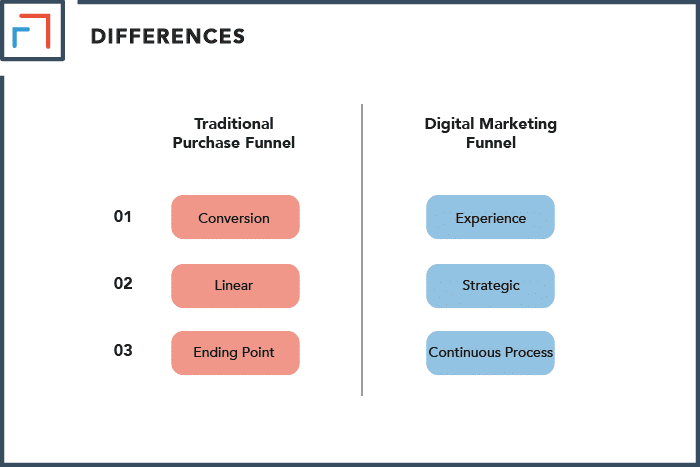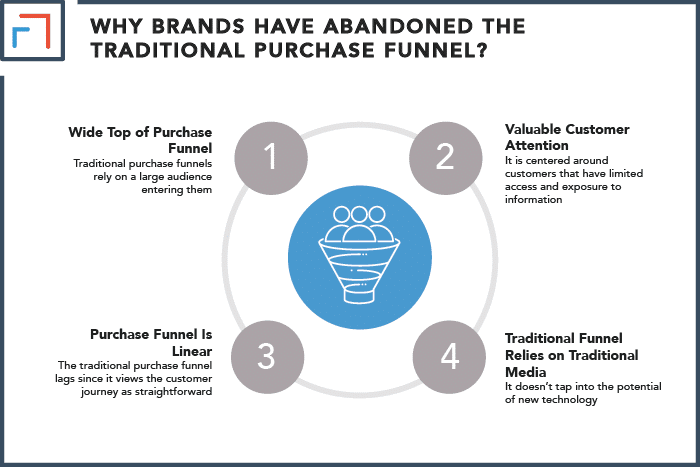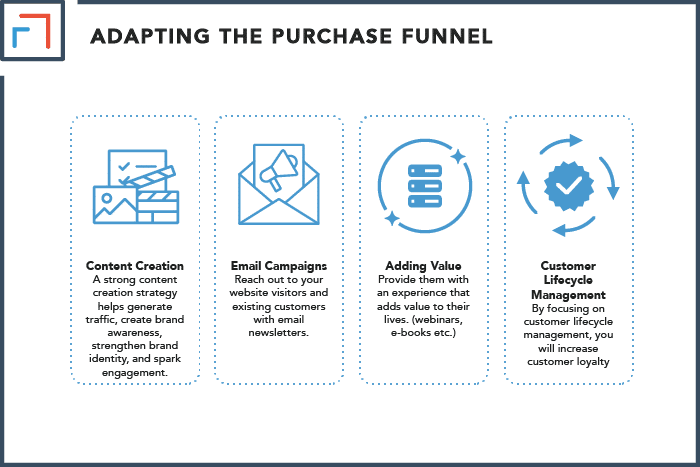If you’re an entrepreneur who is noticing that your traditional purchase funnel is not giving the results you want, you should know that you’re not alone. The traditional purchase funnel was once very effective, but it has been losing steam for years.
The traditional purchase funnel focuses on customer conversion, not providing a great user experience. For this purpose, it has become outdated in the modern marketing world. These funnels have become inefficient because it oversimplifies the customer brand experience.
If you’re curious about the decline of traditional purchase funnels and wondering what has taken their place, read below. This shift is reflective of the marketing world at large, so it’s important to know why things have changed.
Difference Between The Traditional Purchase Funnel & Digital Marketing Funnel
The traditional purchase funnel is becoming obsolete as new marketing strategies emerge that are more effective for modern consumers.
The digital marketing funnel is a popular choice for businesses, and it is quickly replacing the traditional funnel.
1. Conversion Vs. Experience
The traditional purchase funnel, like its name, focuses entirely on pushing the customer to make a purchase.
This is the climax of the traditional funnel, and all its strategies are centered around converting the customer.
On the other hand, a digital marketing funnel uses strategies to deliver a brand experience to the customer even if they never purchase a product or service.
This is because modern consumers are usually more concerned with the value they’re receiving from a brand rather than the functions and features of products.
2. Linear Vs. Strategic
The traditional funnel assumes that the customer will follow the four stages of the funnel in order.
However, digital marketing funnels consider the shifting landscape that customers face nowadays.
So instead of bringing the customer to a specific stage of the brand’s funnel, digital strategies are designed to find customer information and target them at critical points in their journey.
People may bounce around your funnel, so you must find ways to engage them at every stage.
3. Ending Point Vs. Continuous Process
The traditional purchase funnel considers the conversion of the customer to be the final stage.
After a purchase has been made, the focus goes back to finding new customers. A digital marketing funnel’s real work begins after a customer makes a purchase.
In today’s market, brands are built with the support of loyal and satisfied customers.
After conversion, the marketing funnel continues to work on its existing customers. The goal is to develop a strong relationship with them and encourage brand engagement.

Why Brands Have Abandoned Traditional Purchase Funnel?
The traditional purchase funnel dates back to 1898, long before the internet was invented.
This purchase funnel is the blueprint that marketers and companies have used as a base to attract customers and boost their profits.
But the market has transformed in the 21st century because of digital technology and the increasing influence of social media platforms.
As a result, consumers have changed, and their customer journey has become vastly different compared to the previous century.
Let’s discuss some core reasons why businesses have left the traditional purchase funnel behind.
1. Wide Top of Purchase Funnel
Traditional purchase funnels rely on a large audience entering them since it has a wide top and narrow bottom.
In this way, the traditional funnel assumes that customers will first begin their customer journey at the stage of awareness.
However, it doesn’t consider that modern-day consumers have unpredictable customer lifecycles because of digital avenues for instant connection and engagement.
2. Valuable Customer Attention
The traditional funnel is centered around customers that have limited access and exposure to information.
This concept is irrelevant today since customers are actively consuming endless information on different platforms every day.
As a result, customer attention has become a rarity. Companies need to stand out in the sea of brands and information online.
To do so, they must acknowledge the limited time and attention they will receive from viewers if they want to leave a mark.
This approach opposes the traditional funnel strategy of mass marketing.
Modern content must be tailored appropriately because you cannot expect the average customer to watch a 30-minute video or read an entire book about your brand.
3. Purchase Funnel Is Linear
An individual could be exposed to the brand through different means and yet never begin their customer journey.
That is the landscape of digital marketing today. Yet, the traditional purchase funnel lags since it views the customer journey as straightforward and simple.
This is like assuming that when a person is on their way home from the office, they will only go to the bus stop, ride the bus, get off, and walk home.
This assumption does not consider that they could meet an acquaintance on his bus ride, grab drinks with them, stop to pet a cat on the sidewalk, or sit in the park because of the pleasant weather.
Modern consumers bounce around quite a bit and require frequent exposure to a brand before they will commit.
As a result, their process is rarely linear, but the old model doesn’t account for this.
4. Traditional Funnel Relies on Traditional Media
Since the traditional purchase funnel was developed before the existence of digital platforms, it doesn’t tap into the potential of new technology.
For instance, traditional funnels heavily relied on cold calling, yet social media ads are more effective today.
This is because consumers spend a great deal of time online.
So by studying their behavior and trends, brands can better engage with them and pique their interest.

How To Adapt Your Purchase Funnel For A Digital Market?
If you’ve been using a purchase funnel, replacing your strategy entirely might seem overwhelming, especially if you already have an operational business.
Even so, you need to adjust your strategies to use your resources more effectively.
To make this shift easier for you, we’re going to talk about some strategies to include in your funnel.
These techniques will make your brand more relevant and efficient for a modern market.
1. Content Creation
Because there is a ton of competing content online, it’s vitally important for you to make high-quality content that establishes your brand’s presence.
If you make a good impression, you can stand out. When it comes to content, you need to make sure you’re delivering on quality, quantity, and consistency.
A strong content creation strategy helps generate traffic, create brand awareness, strengthen brand identity, and spark engagement.
2. Email Campaigns
Reach out to your website visitors and existing customers with email newsletters.
This is a direct channel between you and the consumer, which allows you to inform them of important product releases and relevant topics.
You could link this strategy with the interest and conversion stages of your traditional funnel.
3. Adding Value
Move away from telling your customers to buy your products. Instead, provide them with an experience that adds value to their lives.
You can do this by improving the buying process for them, offering informational webinars, free ebooks, or by just incorporating suggestions from your customer’s feedback.
4. Customer Lifecycle Management
Look at your customers as lifelong partners. Their journey continues with the brand even after they make a purchase.
With this approach in mind, focus on providing customer service management.
Some brands use virtual reality tours and artificial intelligence like live chatbots to optimize their service and stand out.
By focusing on customer lifecycle management, you will increase customer loyalty and the chance of referrals.

Summary
The marketing world has evolved and so have consumers, so brands must work hard to keep up.
The traditional marketing funnel was designed for a different audience and needs to be adjusted according to fit the needs of a digital consumer.
Using a digital marketing funnel is recommended because it focuses more on the needs of modern consumers compared to the traditional funnel.
